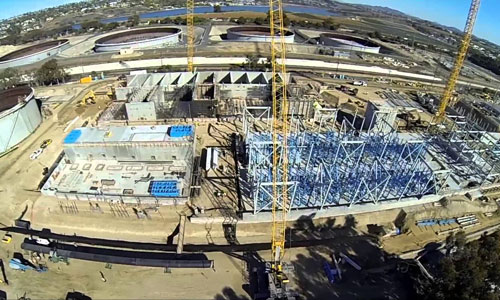Today in Tedium: Salt is a great substance, and one that deserves an important place in our culture. But salt is also the most annoying substance on the planet, in that it makes nearly all of our water supply basically unusable for drinking purposes. Now, removing salt from water is not a painless process, but in an era when drought is a fact of life in places as far-flung as Australia and California, desalination is becoming an increasingly important process for increasing our freshwater supply by just a little bit. Today's Tedium talks about the pluses and minuses of desalination, a topic that is boring as dirt but you should probably know a thing or two about as a matter of course. — Ernie @ Tedium
$238
The price on Amazon of the Aquamate solar still, an inflatable device that can produce up to 2 liters of freshwater per day from a saltwater using a distillation process that converts saltwater to water vapor, then back to water again—removing the salt, but keeping the water. In emergency situations, solar stills can be built by hand using a container, a piece of plastic, a small hole, and a rock. Other solutions exist for desalinating water, but they can get extremely expensive.

The time Thomas Jefferson humored a guy who thought he invented desalination
The process of converting saltwater to freshwater was once an idea of such novelty that it could convince founding fathers to listen to regular people.
Just ask Thomas Jefferson, who spent more than a year humoring a guy who thought he created a surefire desalination process. During a 1790 trip to Newport, Rhode Island, the Secretary of State was given a bottle of purified saltwater by a guy named Jacob Isaacks.
Isaacks, then 71 years old, claimed his proprietary mixture could be added to saltwater and would then filter it just enough to drink. Jefferson, tasked with researching things that would be beneficial to the fledgling U.S. military, took Isaacks' idea seriously, going so far as to create a team of people—including two chemistry professors—to see if they could confirm that Isaacks' idea worked.
The group found that at the very least that the water was slightly better than an untreated equivalent.
"The distilled water in all these instances was found on experiment to be as pure as the best pump water of the city: it’s taste indeed was not as agreeable; but it was not such as to produce any disgust," Jefferson recalled in a 1791 report on Isaacks' creation. "In fact we drink in common life in many places and under many circumstances and almost always at sea a worse tasted, and probably a less wholesome water."
The results were ultimately disappointing, however, as Jefferson and his fellow experimenters could not prove that Isaacks method of production actually removed the salt. "Mr. Isaack's mixture does not facilitate the separation of seawater from its salt," Jefferson stated in an affidavit immediately after the experiment.
Ultimately, Isaacks realized that working with Jefferson on his bajillion-dollar idea was a bit of a dead end, and he began researching other options for his technology, including some promising leads in Europe. Problem was, Jefferson was constitutionally bound to put together a report on desalination, and that report ultimately wasn't favorable to Isaacks' business prospects. Isaacks sent a letter to Jefferson asking him to delay the release of the report, but the secretary of state only received the letter hours after he had submitted the report to Congress.
The lengthy report highlighted the fact that desalination had a history long before Thomas Jefferson knew who Jacob Isaacks was—in other words, Isaacks didn't actually invent desalination. In his letter to Isaacks soon after submitting the report, the future president pointed out a truism of inventing things that's sort of the inversion of Must-See TV: just because it's new to you doesn't mean it's new.
"That the discovery was original as to yourself I can readily believe," Jefferson wrote in his letter to Isaacks. "Still it is not the less true, that the distillation of fresh from seawater, both with and without mixtures, had been long ago tried, and that without a mixture, it produced as much and as good water as in your method with a mixture."
Jefferson may not have had a choice in the matter, but Isaacks was mighty pissed off when he found out.
"Altho’ you were not in possession of my secret which I am fearful wou’d have shared the same fate, you must be thoroughly senceable of the injury that report has done me by making it of Publick use without any advantage to the Discoverer," Isaacks wrote in a very angry letter to Jefferson.
Ultimately though, Jefferson was right—and Isaacks is a guy known to history basically for bugging a future president repeatedly for a couple of years.
54M
The number of gallons of freshwater that can be produced per day at the newly operating desalination plant located in Carlsbad, California. The plant, which has been in the works for nearly two decades at a cost of $1 billion, is somewhat wasteful when it comes to its reverse-osmosis water production process. Nearly two cups of saltwater go in for every cup of freshwater that comes out. Even then, it's not nearly enough water for Southern California's needs; it only represents 10 percent of San Diego County's daily water use.

(Carlsbad Desalination Plant/YouTube Screenshot)
Why environmentalists don't think industrial-scale desalination is a great idea
We've come a long way from the days of Jacob Isaacks and Thomas Jefferson, and now we actually have a variety of processes for desalination that can be replicated around the world—just in time to help parts of the world struggling with drought.
But as a lot of environmentalists will tell you, anything manmade is a process of give and take, and the take of converting saltwater to freshwater is a bit more than the give.
"Desalination: A National Perspective," a 2008 report on the issue by the National Research Council, found that the issues of desalination are often complex and vary based on the specific location. The use of greenhouse gases in producing desalinated water is common, and on top of that, the process can destabilize a local ecosystem and even hurt wider biodiversity throughout the ocean.
"A variety of environmental impacts are possible with desalination. Seawater desalination can cause impingement and entrainment of marine organisms and create ecological impacts from concentrate discharge," the report stated at one point. "Desalination of inland brackish groundwater sources could lead to groundwater mining and subsidence, and improper concentrate management practices can negatively affect drinking water aquifers and freshwater biota."
However, the council noted that research on how desalination can affect specific sites isn't quite there yet.
"Site-specific information necessary to make detailed environmental conclusions on the ecological impacts of both source water withdrawal and concentrate management associated with desalination is lacking," the report added.
https://www.youtube.com/watch?v=rT5C6o7kfaI">in nearby Huntington Beach, are frequently the subject of controversy. It doesn't help that these plants spit extra-briney water back into the ocean in the process of removing the salt for human consumption.
And California is far from alone. Australia has been dealing with similar issues for decades—dry periods come and put desalination back on the table, then it starts raining again, and plans to build desalination plants get paused. Currently, though, Australia is in build mode.
It's a challenging situation, and the end result is simply not going to make everyone happy. But hey, maybe they can mine the result for lithium in the process.
“Human kidneys can only make urine that is less salty than salt water. Therefore, to get rid of all the excess salt taken in by drinking seawater, you have to urinate more water than you drank. Eventually, you die of dehydration even as you become thirstier.”
— The National Oceanic and Atmospheric Administration, helpfully explaining why you can't drink saltwater. Generally, our bodies can't handle drinking saltwater, because it contains more salt than human blood does, and as a result, throws stuff out of whack. In other words, if you're stuck on a desert island, follow the advice of the Dave Matthews Band. Don't drink the water.
Ultimately, though, we have a huge problem—way too much water that humans can't drink—and there are really only two ways to take the pressure off of the massive amount of resource use already going on: either we figure out ways to produce more water, or we consume less.
As the phenomenon of lawn care proves, we're going to have a hell of a hard time consuming less H2O, so what we're really looking for is a solution that can clean a heck of a lot of water in parts of the world that don't get a lot of freshwater naturally. On top of that, the solution has to be relatively cheap, it has to be sustainable, and it has to work in areas that electrical lines don't necessarily reach.
The closest we've gotten to this seemingly impossible goal came in 2014 from a few smart researchers at the Massachusetts Institute of Technology (MIT). The researchers, working with a base that necessitated all of these requirements—villages in India that survive off the electrical grid and have "brackish" groundwater, which is partly contaminated with salt—came up with a solution that was relatively small in size, worked only on solar energy, and could be put pretty much anywhere.
Last year, the MIT team beat out 68 engineering teams from around the world to win the Desal Prize, a $140,000 award handed out by the U.S. Agency for International Development (USAID).
That should come in handy as the team works on a $11,000 version of the device that can create enough fresh water for an entire village.




